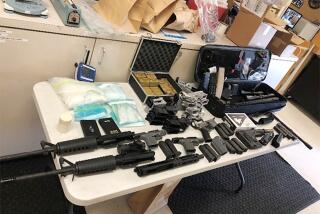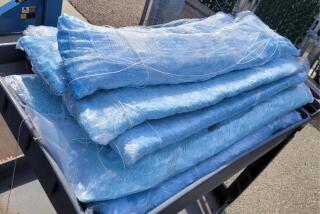218 Drug Fugitives, $1.2 Million in Assets Seized
- Share via
WASHINGTON — The U.S. Marshals Service on Monday announced the apprehension of 218 major drug fugitives, including 12 charged with trafficking who had been at large at least eight years.
Marshals Service Director Stanley E. Morris called the 10-week manhunt cost-effective, noting that the seizure of $1,266,521 in cash and property that came with the arrests more than covered the $1.1-million cost of the operation.
“These drug criminals paid for their own capture,” Morris said of the bail-jumpers and suspects who had evaded arrest. The effort was aided by a computer program that sifted reams of data to produce leads.
In the operation--run out of El Paso and Galveston, Tex., New Orleans, Mobile, Ala., and Jacksonville, Tampa and Miami, Fla.--agents picked up 84 Class I and II violators, as the Drug Enforcement Administration calls leading figures in criminal organizations, illicit drug laboratory operators, pharmacists or doctors who abuse their licenses in dispensing drugs, and corrupt public officials.
Among those arrested was Nicholas Hunter-Reay, who fled cocaine distribution charges in Los Angeles nine years ago and had been living under the name Paul Matthews as an apparently prosperous and civic-minded businessman in Delray Beach, Fla. In what Morris called “the ultimate irony,” the community services carried out by “Matthews” included membership in the substance-abuse committee of the sheriff’s advisory council in Broward County, Fla.
Hunter-Reay’s property accounted for more than half the assets seized in the arrests: $718,000, including Mercedes-Benz and Ferrari Testarossa automobiles, custom-made clothing and jewelry, collections of coins and ivory and a large amount of cash, according to the Marshals Service. He allegedly was a partner of Carlos Lehder-Rivas, the recently convicted member of the notorious Medellin drug cartel in Colombia.
Charged with possession and conspiracy to distribute 12 kilograms of cocaine (which officials said had a 1979 street value of $1.2 million), Hunter-Reay had a reputation for violence and authorities recommended that his bail be set at $5 million, according to the Marshals Service.
Hunter-Reay’s apprehension typified the multiple-agency nature of the manhunt. It resulted from the work of DEA agents in San Diego, the organized crime drug enforcement task force in Los Angeles, marshals’ enforcement unit in Miami and Delray Beach police, who assisted in the arrest.
The roundup was called WANT-II (Warrant Apprehension Narcotics Team). A prototype, WANT-I, conducted from March through May, 1987, resulted in the arrests of 166 drug fugitives.
Computer Data Search
In the latest operation, a computer program designed by the marshals stored and sorted large amounts of data from case files to develop leads for investigators.
Howard Safir, the marshals’ associate director for operations, described the program, known as Scorecard, as “the thinking man’s way of catching fugitives.”
Nevertheless, the scope of the fugitive problem remained wide. Morris said the sweep reduced by about 5% a backlog of 4,200 arrest warrants for major drug fugitives.
More to Read
Sign up for Essential California
The most important California stories and recommendations in your inbox every morning.
You may occasionally receive promotional content from the Los Angeles Times.










